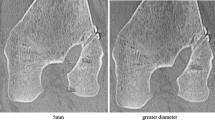Abstract.
Changes in the femoral and tibial bone tunnel were studied prospectively after arthroscopic ACL reconstruction with quadruple hamstring autograft. To determine whether tunnel enlargement can be decreased by fixing the graft close to the joint line having a stiffer fixation construct we compared "anatomical" (one absorbable interference screw femorally, and bicortical fixation with two absorbable interference screws tibially) and extracortical fixation techniques (Endobutton femorally, and two no. 6 Ethibond sutures over a suture washer tibially). Over a 2-year period we evaluated 60 patients clinically (IKDC scale, Cincinnati Knee Score, KT-1000) and radiographically (confirmed by MRI). The operated knee was radiographed immediately postoperatively and 6 and 24 months postoperatively. The femoral and tibial bone tunnel diameter was measured on anteroposterior and lateral images, and the tunnel area was calculated and compared to the initial area calculated from the perioperative drill size. In the "anatomical" group the immediately postoperative bone tunnel area was 75% larger than the initial tunnel area, after 6 months it was increased another 31%, and between 6 and 24 months it remained basically unchanged. In the "extracortical" group there was no significant enlargement immediately postoperatively, but after 6 months it was 65% larger than the initial area of drill and graft size, and between 6 and 24 months it decreased to 47%. There was no correlation between the amount of tunnel enlargement and clinical scores or KT-1000 measurement. Arthroscopic ACL reconstruction with quadruple hamstring autograft is associated with bone tunnel enlargement. Using a purely extracortical fixation technique thus significantly increased the tibial and femoral tunnel area during the first 6 postoperative months, while it decreased slightly thereafter. The insertion of large interference screws apparently not only compresses the graft in the bone tunnel but also significantly enlarges the bone tunnel itself. The immediate enlargement at the time of the operation is followed by a reduced further enlargement at 6 months and then stabilization. Tunnel widening did not influence clinical outcome over a 2-year period.
Similar content being viewed by others
Author information
Authors and Affiliations
Additional information
Electronic Publication
Rights and permissions
About this article
Cite this article
Buelow, JU., Siebold, R. & Ellermann, A. A prospective evaluation of tunnel enlargement in anterior cruciate ligament reconstruction with hamstrings: extracortical versus anatomical fixation. Knee, Surg, Sports Traumatol, Arthrosc 10, 80–85 (2002). https://doi.org/10.1007/s00167-001-0267-6
Received:
Accepted:
Published:
Issue Date:
DOI: https://doi.org/10.1007/s00167-001-0267-6




